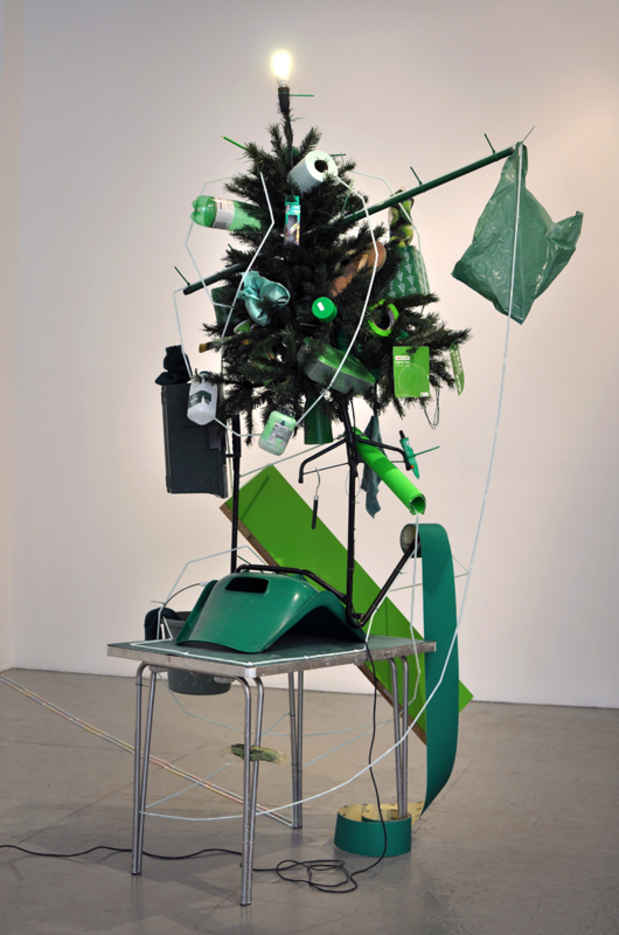Caroline McCarthy "Made To Measure"
Parker's Box

This event has ended.
In his book New Art from London, Chris Townsend describes Caroline McCarthy’s work as addressing “the distortion of utopian projects and ideals into commodities”. McCarthy is acutely aware of the way in which our lives are invaded and infiltrated from every angle by design, generally based on enhancing the banal object to render it desirable and thereby marketable. McCarthy’s area of interest lies in the potential of subtly transforming the presence of those familiar objects that normally don’t warrant a second glance, so that we become aware of them in new ways, making the spectator’s perception one of the artist’s tools. A by-product of this process, albeit a powerful one, is the subtle re-contextualizing of “quotidian mass-produced objects (drinking straws, shelving, soft drink cans) to the privileged status of art object” as described by Gemma Tipton in Artforum’s Critics’ Picks, earlier this year. Tipton goes on to state that: “Found objects are transformed not simply by selection but by artistic manipulation, and in McCarthy’s hands, the results are not only aesthetically pleasing but intellectually satisfying, too.”
In her previous exhibitions at Parker’s Box, Caroline McCarthy pursued her signature management of the spectator’s perception of familiar objects. Plastic bottles for household products (that we are conditioned to recognize due to their bright colors) were transformed with nothing more than subtle shades of grey, silver and black, into what seemed for all the world to be unfamiliar designs of cameras and electronic devices. More recently, McCarthy presented finely executed drawings and watercolors depicting piles of garbage, observed in the surrounding streets. In rendering beautiful what is normally ignored and considered unaesthetic at the very least, the unexpected marriage of subject and medium once again subtly guided the spectator towards further consideration of the consumer society, and our relation to it and the mass-produced objects it disgorges.
In the current exhibition, Caroline McCarthy has taken this reflection further, while also remaining faithful to works in which she uses “conventional” artistic virtuosity to pursue her examination of objects that are both her subject in certain works, and her materials in others. In Made to Measure, the humble plastic drinking straw is the subject of a series of meticulous ink drawings on gessoed boards, while at the same time the straw itself becomes the tool and medium of a linear ‘drawing’ that circumnavigates the perimeter of the gallery space in an installation piece titled Group Coordination (Green). At some point this line ventures away from the periphery towards the focal point of the exhibition, a large green sculptural form with a Christmas tree enmeshed at its core. It is a form the artist developed through ‘decorating’ the tree with a variety of objects found in her studio, from a chair to an old broom handle, the only criteria for an object’s inclusion being that it is green. As is typical of her approach, it is the banal attributes – the surface veneer - of everyday material which guide towards a given outcome.
Another work titled Production is composed of a ceramic vase (inexpensive but of recent design) and a video projection. Here, the artist is once again intent on getting under the skin of her chosen object, presented (preciously) on a pedestal under glass, while also occupying the starring role in the accompanying video. For the video, the vase was equipped with a camera and then kicked around the artist’s studio, providing jolting, dizzying, out-of-focus images that might even provoke the Nausea of Sartre’s novel of that name, in which the hero’s nausea comes from his realization that the contingency of existence applies as much to humans as it does to objects. In Caroline McCarthy’s piece, the vase testifies to its role in the film by showing off its numerous scratches and scrapes – damage that diminishes it’s value as a vase, while simultaneously and gently elevating it (with a sprinkling of humor), to the status of an art object, in much the same way as Duchamp’s subtle transformations of another, more famous piece of ceramic.
In the final work to be encountered, titled The End in Black and White, two floating shelves are mounted on their sides, effectively rendering them useless as shelves. Instead, they become perfectly sized supports for found ends of broken shoelaces, a white one placed on the black shelf and vice versa. If the Christmas tree sculpture hints at neo-pop assemblage, we find ourselves closer here to a kind of Ikea Judd, sliding into shades of Beuysian arte povera, in which the old shoelaces seem to inspire mystical nostalgia and memory. Through the simplest of means, Caroline McCarthy combines an inter-connecting logic with a lightness of touch, a sense of humor and poetics particular to her curiosity and exploration: how to make something; how to look at it; how to give it meaning; how to make sense of it.
Media
Schedule
from November 11, 2011 to December 24, 2011
Opening Reception on 2011-11-11 from 18:00 to 21:00